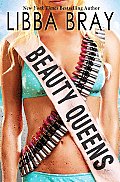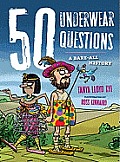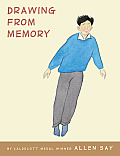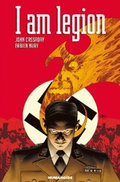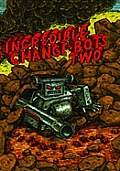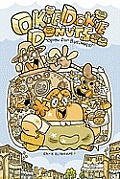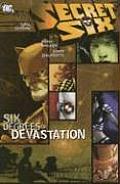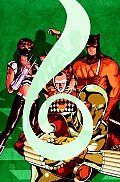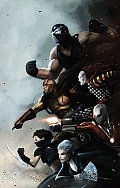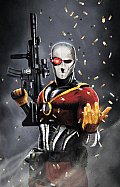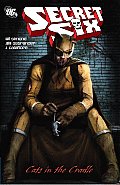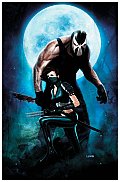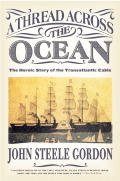Link to this review in the form of a comic strip by dawnrutherford tagged coming of age • humor • thriller
Link to this review by flemtastic tagged history • nonfiction • picture book
This third book in the 50 Questions series deals with underwear through the ages and what it tells us about different time periods. Ancient weaving techniques made early undies simple and uncomfortable, religion led to an abundance of cloth, and modern advertising (a jeans model baring his waistline) made sales soar. The book even tastefully explores the whale tail that appears when a thong is worn with low-rise jeans.
Why I picked it up: It features cartoony art that mocks historical times while making them interesting to kids — I flipped through it and saw a drawing of ridiculous, ruffle-wearing Victorians advising loincloth-clad natives that they looked silly.
Why I finished it: I learned a lot, particularly from the sidebars in the form of small notes shaped like underwear tags. Long Johns were named after John L. Sullivan, the bare knuckles boxer who liked to fight in ankle-length woolen leggings. Jockstraps were created for the benefit of bike couriers on the cobblestone streets of Boston who needed a little more support for their jiggly parts. And Joe Boxer, the underwear company, had a run of boxers confiscated by the Secret Service because it was covered in representations of 100 dollar bills.
I’d give it to: Alex, who would follow the instructions on how to create his own pair of subligaculum (Roman gladiator underwear).
Link to this review by geneambaum tagged graphic novel • picture book • biography
Caldecott Medal winning artist Say tells his own story in text, photographs, drawings, comics, and sketches. Say was obsessed with drawing at an early age. At age thirteen, to attend a prestigious middle school in Tokyo, he lived alone in his own apartment and turned his apartment into a studio. There Say read about a boy named Tokida who walked from Osaka to Tokyo, determined to become a cartoonist. Tokida was taken on as apprentice by Noro Shinpei. Say then sought out Shinpei and became his student as well.
Why I picked it up: I’m not familiar with Say’s work, but I flipped through a galley when I saw it at the Scholastic booth at a library conference. His art is absolutely stunning, particularly his subtle use of color, so I took it to read.
Why I finished it: Shinpei’s advice really helped Say’s art mature, and it’s fascinating to see the re-creation of this process in the book. But the high point for the big comic fan in me was when his sensei introduced him and Tokida as characters into his famous “Demokurashee-can” comic strip.
I’d give it to: Stephen Robson, the fine gentleman in charge of Fanfare, who introduces me to newly translated foreign comics every year at Comic Con. He just gave me Jiro Taniguchi’s fictionalized biography about how he became a mangaka, A Zoo in Winter, so I know he’ll appreciate this.
Link to this review by snow tagged paranormal
While walking to meet friends, Delaney falls through the ice of a frozen lake and drowns. Her best friend Decker pulls her out and resuscitates her. The doctors don’t expect her to ever wake up, but she does and seems to be perfectly fine.
Delaney knows that something is wrong with her. She gets a weird itchy feeling in her brain around certain people. Those people die soon afterwards. The question Delaney wants answered, though, is whether she is feeling death or causing it to happen.
Why I picked it up: I read a bit, and Delaney’s slightly sarcastic voice in the first chapter caught my attention. She sounded like someone I could be friends with.
Why I finished it: Delaney moved from being a driven, tightly wound teenager to a girl who was sure she was losing her mind. She comes to understand that life isn’t fair, but it is still usually worth living.
I’d give it to: Taylor, because the minor paranormal element of Delaney being able to sense death will catch her attention, and she’ll be sucked into the story before she realizes that it is mostly realistic.
Link to this review by billba tagged graphic novel • horror • paranormal
It’s 1942, and a ten-year-old Romanian girl sees through the eyes of a cat who has licked a drop of her blood. It’s not just cats; it also works with people, specifically soldiers, and in her the Nazis see a powerful new weapon.
Meanwhile, in Britain, a crack team of detectives is sent to investigate the mysterious death of a rich and powerful man who died under mysterious circumstances (he was left with no blood at all).
Why I picked it up: John Cassaday is my favorite comic artist working today. I’d buy a pack of Altoids if he illustrated it (plus it would give the term “mint in box” a whole new meaning).
Why I finished it: Amidst the supernatural carnage there is a tender and sad romance between the chief investigator and his secretary. It’s one of many solid character moments which ground the story and keep it human.
I’d give it to: Paul, who can’t resist the words “Nazi” and “vampires” used in conjunction, and will love Laura Martin’s moody colors.
Link to this review by geneambaum tagged science fiction • graphic novel
At the end of book one, the Change-Bots left Earth to look for a new home. They left behind a confused, amnesiac Shootertron who was taken in by farmers Edna and Stanley who gave him his own room and let him help out on the farm. He became junior class president and learned about his power (shooting things with the giant cannon on his arm). But then his arch-rival at school brought Shootertron’s diary to the government. Agents were dispatched to bring the robot in so that he could be used as a weapon.
Meanwhile, the Change-Bots accidentally return to Earth. Old rivalries reappear. Some shooting ensues.
Why I picked it up: Incredible Change-Bots One was the goofiest, funniest sendup of the whole transforming-robot genre of cartoons/comics that I could imagine.
Why I finished it: The backstory. “Unable to agree on several insignificant details, the Awesomebots and Fantasticons waged a fierce war against each other. With their planet decimated, the Change-Bots set aside their differences and left to look for a new home…” “We could clean this all up.” “Nah, it’d be easier to just start fresh.”
I’d give it to: Max, one of the most imaginative kids I know, because then he’d be yelling, “Incredible Change!” while “transforming,” just like the robots do.
Link to this review by gigi tagged graphic novel • humor
Okie Dokie Doughnuts is run by Big Mama. Everyone loves her donuts. After the morning crowd clears out she and Henry (her helper) clean up. Henry is kind of clumsy so big mama thinks she might need an extra pair of hands. She tries out a donut-making robot, Mr. Baker.
Why I picked it up: I like the happy robot on cover that’s holding a donut.
Why I finished it: It’s really funny when Henry puts the trash into Mr. Baker, and Mr. Baker starts making crazy donuts like chocolate fish and strawberry socks.
I’d give it to: Grace, because she likes donuts, and she’ll like the part where a guy about to take a bite of a jelly donut accidentally squeezes it and shoots jelly all over his face.
Link to this review by sarahhunt tagged superhero • graphic novel
Six supervillains band together to work for money instead of power or revenge, mostly because they’re tired of being bossed around and labeled by others. Sometimes they get paid, but usually things go sideways, and they barely escape with their lives.
Why I picked it up: I hear Gail Simone’s name spoken in admiring tones by writers and artists I respect. One of the Secret Six volumes came across my desk, so I gave it a try.
Why I finished it: Simone gave believable motivations to a team of baddies that made me love them. Each one has a realistic reason for being angry and lashing out: child abuse, loneliness or addiction. They find ways to connect with team members who understand what they’ve faced, and start to think about how they might be able to change for the better while staying tough because they need to survive.
I’d give it to: Hunter, for the character who turns to violence to stop the abuse in his home and then wonders if that has to define him forever. Six, for the character who never had a childhood but decides he can be a father figure for someone who needs one. Edward, for the hilarious scenes where Catman figures out what Batman had for lunch and Deadshot makes Ragdoll afraid of flying.
Link to this review by flemtastic tagged nonfiction
When King George II died in 1760 (a blood vessel burst while he was in his water closet), it took almost eight weeks for the news to reach America. Ships became faster, but businesses and governments often had to make financial and policy decisions based on outdated information. Then Cyrus Field, an American businessman, heard about a twenty mile underwater telegraph cable between Britain and France. It gave him the inspiration to run a 2,000 mile cable between Ireland and Nova Scotia, the shortest route across the Atlantic. Both the American and British governments got on board, as did Lord Kelvin and Samuel Morse. Laying the Atlantic Cable took fourteen years of struggle, fundraising, engineering feats and finally failed attempts to complete the first message (though it was eventually transmitted by Queen Victoria).
Why I picked it up: The cable was mentioned obliquely in the Young Sherlock Holmes book, Rebel Fire. The footnotes mentioned this book.
Why I finished it: Many thought the idea was the height of foolishness, including members of the esteemed Royal Astronomical Society who came out against it as scientifically impossible. (They also decried space travel as “utter bilge” two years before Sputnik orbited the Earth.)
I’d give it to: Rohit, a student of mine who has the same stick-to-it stubbornness that allowed Cyrus Field to succeed.
